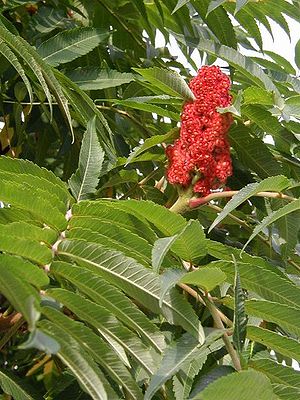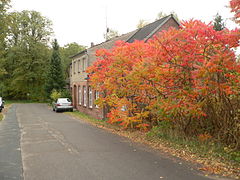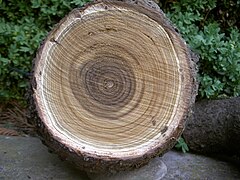Vinegar tree
| Vinegar tree | ||||||||||||
|---|---|---|---|---|---|---|---|---|---|---|---|---|

Vinegar tree ( Rhus typhina ), |
||||||||||||
| Systematics | ||||||||||||
|
||||||||||||
| Scientific name | ||||||||||||
| Rhus typhina | ||||||||||||
| L. |
The vinegar tree or deer piston umach ( Rhus typhina L .; Syn .: Rhus hirta (L.) Sudw. ) Is a type of plant within the sumac family (Anacardiaceae). It comes from eastern North America . The vinegar tree was introduced in Europe around 1620 and is a widespread ornamental wood because of its distinct autumn colors. The leaves turn yellow, later orange and in October bright crimson. Its common German name Hirschkolbensumach as well as the English name staghorn sumac are based on the characteristic feature of the species: the strong, brown, tomentose young twigs that are reminiscent of deer antlers overgrown with bast.
description
Appearance and wood
The deciduous vinegar tree grows as a deciduous shrub with stature heights of mostly 3 to 5 meters or, under favorable conditions, it can form a multi-stemmed small tree up to 12 meters high in its natural range . Usually this species grows in a shrub-like manner with broad crowns and short, crooked stems with a maximum stem diameter of 35 cm ( BHD ). On nutrient-poor, sandy soils, they can form numerous young shoots from shallow roots , which develop into small thickets and often overgrown up to ten meters from the trunk. The rather smooth bark of older trunks is greyish and slightly cracked to scaly, the bark of older branches is covered with numerous orange-brown cork pores ( lenticels ).
The wood is light, soft and brittle. It has an almost white splint and a green, striped, orange core . The vessels are arranged in groups and tend to become vertylated . A little known property of wood is its fluorescence . Under UV light it shows a strong neon yellow glow (the color may vary).
Branch, bud and leaf
The vinegar tree does not form any terminal buds in the crown area . The cone-shaped winter buds are about 1 centimeter long and dense, hairy brown tomentose; Bud scales are missing.
The bark of the young twigs is hairy with thick brown felts; the branches bald after three to four years. They have a round pulp of orange-brown color and contain a white, sticky milky sap that leaks out when injured and turns black around the area. The end shoots close with an inflorescence , further growth is taken over by side buds ( sympodial branching).
The alternate leaves are 20 to 60 centimeters long and divided into petioles and leaf blades. The 5 to 10 cm long leaf stalks and the rachis are greenish to reddish and more or less, shorter or longer, softly hairy. The veins on the underside of the leaf are also hairy. The imparipinnate leaf blade consists of 9 to 31 mostly oppositely arranged leaflets . The upper side of the leaf is green and slightly shiny, the underside is matt-light green. Only the terminal leaflet is usually petiolate. The length of the almost sedentary to sedentary leaflets is between 8 and 12 cm, the width between 2 and 3 cm, with the middle leaflets being the largest. The shape of the leaflets varies from ovate, elliptical to oblong-lanceolate, often they are slightly sickle-shaped. The base is rounded, half-heart-shaped and somewhat unevenly shaped; the upper end tapers to a point. The leaf margin is unevenly serrated, but the tip is serrated with the entire margin. The vinegar tree is particularly noticeable because of its autumn color, the leaves turn yellow, later orange and in October they turn bright crimson. The veins of the leaflets are pinnate and slightly raised underneath.
Inflorescence and flower
The vinegar tree blooms in early summer after the leaves have sprouted. It is usually dioecious, separate sexes ( diocesan ) and the female flowers usually appear about a week before the male. The flowers are in terminal, upright, pyramidal and yellow-green, thyrsig - rispigen and finely hairy inflorescences together. The male, looser inflorescences are up to 20-25 cm long and thus about a third larger than the more compact female inflorescences. Each stalked flower has a 1.5 mm long and 0.5 mm wide bract , the inside of which is hairy. The single flower with double flower envelope is five-fold and the flower stalks are hairy. The green calyx is five-lobed, long-haired on the outside and bald inside and has a length of 1.5 mm. The slightly boat-shaped, elongated petals are yellowish-green in the male flowers, greenish in the female, 3.5 mm long, 1.5 mm wide and slightly hairy. In the male flowers, the petals are laid back, in the female they are more upright. Each flower has a showy, orange and lobed disc . The upper, hairy and unicameral pistil has three short styles , each with a stigma , male flowers have five free stamens with large, orange-yellow colored stamens and a stunted ovary .
| Flower formula : | male flower: | |
| female flower: |
Fruit and seeds
The fruits are dry and red drupes , 4 mm long, 4.5 mm wide and somewhat flattened. They are fully grown in August and mature in autumn. Fruit development without prior fertilization ( parthenocarpy ) is common. The fruits are surrounded by a dense, shaggy layer of long, red and soft (glandular) hairs. The small, solitary, egg-shaped to elliptical, somewhat flattened and smooth stone core is light brownish. The stone cores are approx. 2.5 mm long and 2 mm wide and the seeds in them do not contain any endosperm , i.e. no nutrient tissue. The seeds are often spread by birds and germinate epigeously . The thousand grain weight is 11 g.
Chromosome set
The number of chromosomes is 2 n = 30.
Toxicity and Ingredients
All parts of the plant are poisonous, although the degree of toxicity is low or the toxicity is even questionable. Oral ingestion of larger quantities leads to stomach and intestinal problems, the milk sap on the skin is said to lead to skin inflammation, splashes in the eyes can trigger conjunctivitis.
The main active ingredients are tannins , ellagic acid and the strongly acidic cell sap. Urushiole as in poison sumac cannot be detected.
Distribution and location requirements
The natural area is in the eastern United States and Canada . It stretches from New Scotland and the lower part of the Saint Lawrence River west to Iowa and Lake Huron , south along the Appalachians to Georgia , Alabama , Mississippi and Florida . As an ornamental wood for gardens and parks, the vinegar tree is used particularly in Central and Northern Europe and is considered a naturalized neophyte in Germany . For Austria, the information is rare and absent-minded wild . In Switzerland it was added to the black list of invasive neophytes . Production and placing on the market of Rhus thyphina are prohibited (Federal Release Ordinance (SR 814.911), Appendix 2).
The species finds optimal growing conditions on nutrient-rich soils on the sunny southern slopes of West Virginia , Tennessee and Kentucky . There you can find them individually, in small groups or thickets in open terrain. It does not occur as undergrowth in forests. It makes little demands on the soil, grows on both limestone and primary rock and is also used as protection against erosion on dry, nutrient-poor locations. Wet, acidic and cold soils are avoided. In its homeland, the species is part of the pioneer and forest shrubs from the order Rhoetalia typhinae.
The vinegar tree is very cold-resistant.
Systematics and botanical history
In the genus Rhus , which includes around 150 species , the species is assigned to the Sumac section , the characteristics of the section are flowers in terminal inflorescences , densely hairy, red fruits and unpinnate leaves.
Carl von Linné placed the vinegar tree in his Species Plantarum in the genus of the false hemp in 1753 and named it Datisca hirta . He may have obtained material for the vinegar tree from a trip to North America by his student Pehr Kalm . Later he placed the vinegar tree as Rhus typhina in the genus Rhus . The epithet typhina is derived from the generic name of the cattail Typha , which means roughly cattail-like and describes the shape of the fruit stands. The type epithet hirta is Latin and means 'rough-haired', 'bristly'. The epithet hirta from 1753 is older than typhina from 1756. The older should have been used. But since Rhus typhina was an economically important and long-established name for the vinegar tree, the Basionym Datisca hirta was declared a name that cannot be used ( nomen utique rejiciendum in Melbourne ICN Article 56) and so Rhus typhina remains the valid name. The German name Hirschkolbensumach is derived from the young shoots that are reminiscent of deer antlers. The name vinegar tree goes back to the fact that its acidic fruits were added to the vinegar in order to strengthen its acidity.
use
For some Indian tribes, Rhus hirta was of medicinal importance. The roots served as a means to stop bleeding, the fruits helped against diseases of the lungs and the tea from the inner root cortex relieved "internal complaints". The inner bark was used to make a light yellow color for war paint or for dyeing fabrics.
The as Indian Lemonade designated soft drink is produced from water and the fruit of the tree vinegar and has a high content of vitamin C on. The fruits are sometimes used in making vinegar. An oil can also be obtained from the fruits.
The light, brittle wood is of no economic importance, but is suitable for carpentry or for coarser constructions. Pipes can be made from young shoots.
However, Rhus typhina was important as a source of tannin . The root bark and leaflets in particular have a high content, with only the leaves being used. They contain prior to the onset of the fall foliage 27 to 29% tannin (based on the dry weight ), of the well-suited for the tanning of leather is suitable. In the USA and several European countries particularly high tannin varieties (peak values up to 42%) were grown. The yields in America were around 140 kg per hectare and year, and in Europe even more. However, they are below the yields that can be achieved with the species Rhus glabra and Rhus coppalina . It was grown for tanning in the USA, the former Czechoslovakia , Russia, Hungary and Germany. Today there are still growing areas in Pakistan .
In Europe the vinegar tree is used as a popular and widespread ornamental wood. It was brought to France around 1620 and is documented in a Paris garden in 1621 as "Sumac de Virginiana". From 1628 he can be proven in Leiden , from 1629 in London. In Germany it can first be found in a ducal Brunswick garden, where it came between 1630 and 1651, and in 1654 also in Königsberg in Prussia . But until the end of the 18th century it was rarely cultivated in botanical or other gardens. At the beginning of the 19th century it was listed in a German directory as a common pleasure bush plant . It was not widely used in green areas and gardens until the second half of the 20th century.
The slit-leaved forms have horticultural significance :
- Rhus typhina 'Dissecta' with deeply incised leaflets
- Rhus typhina 'Lacinata' with additional heavily slashed bracts in the inflorescence
literature
- Peter Schütt (Ed.): Encyclopedia of Bushes . Nikol, Hamburg 2006, ISBN 978-3-937872-40-7 , pp. 267-274 (special edition, excerpt from: Peter Schütt (Ed.): Encyclopedia of Woody Plants - Handbook and Atlas of Dendrology. Loose-leaf collection , ecomed, Landsberg am Lech 1994-2008 / Wiley-VCH, Weinheim 2008 ff., ISBN 3-609-72030-1 ).
- Wolfram Buff, Klaus von der Dunk: Poisonous plants in nature and the garden . Paul Parey, 1988, ISBN 3-489-55222-9 .
Individual evidence
- ^ R. Bruce Hoadley: Wood as a material. Ravensburger 1990.
- ↑ Roth, Daunderer, Kormann: Toxic Plants, Plant Poisons . 4th edition. Nikol, Hamburg 1994, ISBN 3-933203-31-7 , pp. 616-617.
- ↑ Vinegar tree. In: USDA. Accessed June 10, 2008.
- ↑ FloraWeb, accessed June 8, 2008.
- ^ Manfred A. Fischer , Karl Oswald, Wolfgang Adler: Excursion flora for Austria, Liechtenstein and South Tyrol. 3rd, improved edition. State of Upper Austria, Biology Center of the Upper Austrian State Museums, Linz 2008, ISBN 978-3-85474-187-9 .
- ^ Federal Office for the Environment FOEN: Invasive Alien Species . ( admin.ch [accessed on August 6, 2019]).
- ↑ S. Buholzer, M. Nobis, N. Schoenenberger, S. Rometsch: List of the alien invasive plants of Switzerland . Ed .: Infoflora. ( infoflora.ch [accessed on August 6, 2019]).
- ^ Erich Oberdorfer : Plant-sociological excursion flora for Germany and neighboring areas . With the collaboration of Angelika Schwabe and Theo Müller. 8th, heavily revised and expanded edition. Eugen Ulmer, Stuttgart (Hohenheim) 2001, ISBN 3-8001-3131-5 , pp. 645 .
- ↑ Helmut Genaust: Etymological dictionary of botanical plant names. 3rd, completely revised and expanded edition. Nikol, Hamburg 2005, ISBN 3-937872-16-7 (reprint from 1996).
- ^ Rhus in the Germplasm Resources Information Network (GRIN), USDA , ARS , National Genetic Resources Program. National Germplasm Resources Laboratory, Beltsville, Maryland. Retrieved December 5, 2015.
- ↑ a b Heinz-Dieter Krausch : Kaiserkron and Peonies red ... From the discovery and introduction of our garden flowers . Deutscher Taschenbuch Verlag, Munich 2007, ISBN 3-423-34412-1 , p. 391 f.
- ↑ Wolfram Buff, Klaus von der Dunk: Poisonous plants in nature and the garden . 2nd revised edition. Paul Parey, Berlin / Hamburg 1988, ISBN 3-489-55222-9 , pp. 111 .
- ↑ Indian Lemonade. In: Floridata. Accessed June 8, 2008.
Web links
- Vinegar tree. In: FloraWeb.de.
- Distribution map for Germany. In: Floraweb .
- Rhus typhina L. In: Info Flora , the national data and information center for Swiss flora .
- Thomas Meyer: Data sheet with identification key and photos at Flora-de: Flora von Deutschland (old name of the website: Flowers in Swabia )
- Vinegar tree. In: Baumkunde.de. (with photos)
- Rhus typhina In: US Forest Service.
- Recognize & combat neophytes - Essigbaum (information film of the Canton of Thurgau)











